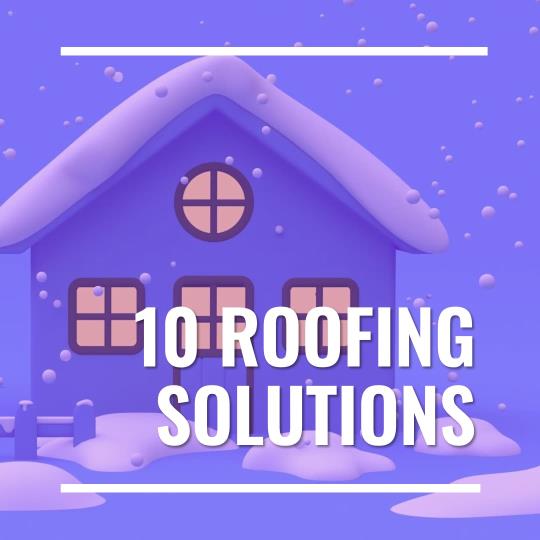Think about using strong roofing to protect your home from bad weather. Metal roofing is great because it can handle wind and fire. Asphalt shingles that don’t get damaged are good for places with lots of hail and storms.

Concrete or clay tiles are also strong against wind and fire. Synthetic materials and metal roofs with special seams are available for more protection. If you like being green, you can choose roofing that supports plants or collects solar energy.
Rubber tiles that look like slate and wood shakes treated to last longer are good for a classic style. There’s also a light, tough type of roofing made from impact-resistant polymer that’s good for all kinds of bad weather. It lasts long, saves energy, and doesn’t need much upkeep.
1. Metal Roofing
Metal roofs are favored for their resilience. They can handle high winds, hail, and even fire, making them perfect for areas that experience severe weather. They last a long time with minimal upkeep, and their durability makes them a smart choice for protecting your home against nature’s fury.
2. Asphalt Shingles with Impact Resistance
Impact-resistant asphalt shingles are the way to go for an option that doesn’t skimp on protection. Designed to withstand hail and severe storms, these shingles defend against damage, ensuring your home remains intact even when the weather turns rough.
3. Concrete or Clay Tiles
Both concrete and clay tiles bring a combination of durability and aesthetic appeal to your roofing. They’re tough against high winds, hail, and fire, offer excellent insulation, and are resistant to rot, insects, and mold. Their longevity and low maintenance make them stand out in extreme weather conditions.
4. Synthetic Roofing Materials
Innovative synthetic roofing, including composite shingles and rubber roofing, provides a durable and weather-resistant covering for your home. These materials are designed to imitate the look of natural products while offering superior protection from the elements.
5. Standing Seam Metal Roofing
Standing seam metal roofing features raised seams that lock together to keep wind and water at bay. Its robust design is ideal for regions that face hurricanes or heavy snowfall, providing exceptional defense against extreme weather.
6. Green Roofing
Green roofs, covered with vegetation, aren’t; they’re also effective in managing heavy rainfall and insulating homes against extreme temperatures. While not traditional, they’re gaining popularity for their sustainability and unique protective qualities.
7. Solar Tiles
Solar tiles combine the benefits of solar energy generation with durable roofing. While they can be pricier upfront, they can withstand harsh weather conditions and reduce energy bills, making them a smart investment in the long run.
8. Rubber Slate Tiles
Rubber slate tiles offer a classic look with enhanced durability and weather resistance. They’re particularly effective in areas prone to hail or severe storms, providing reliable protection without the weight and fragility of natural slate.
9. Wood Shakes with Treatments
Treated wood shakes are prepared to resist fire, rot, and insect damage, making them a viable roofing option in extreme weather. While they require more maintenance than other materials, their natural appearance and improved durability appeal to many homeowners.
10. Impact-Resistant Polymer
Impact-resistant polymer roofing is designed to endure severe weather, from hailstorms to high winds. These materials are lightweight, durable, and available in various styles, offering protection and aesthetic flexibility for your home.
Ensuring Your Roof’s Longevity
Choosing the right material is the first step in protecting your home from extreme weather. Proper installation and regular maintenance ensure these materials perform as intended. It’s crucial to work with qualified professionals who understand each material’s requirements and ensure your roof is prepared to withstand the elements.
The Value of a Durable Roof
Investing in a durable roofing solution is about immediate protection and long-term savings. A roof that can withstand extreme weather conditions is less likely to need frequent repairs or replacement, saving you money.
Additionally, some materials, like metal roofs, can improve your home’s energy efficiency by reflecting sunlight and reducing cooling costs in warmer climates.
According to the Insurance Institute for Business & Home Safety (IBHS), metal roofs are among the most effective in resisting severe weather.
Furthermore, choosing impact-resistant shingles can provide added peace of mind by offering enhanced protection against hail and storms. The right roofing solution can improve your home’s safety, efficiency, and value.
Wrap UP
Protecting your home from extreme weather starts with selecting the right roofing solution. Many choices, from durable metal options to innovative synthetic materials, suit different needs and preferences.
Investing in a roofing system capable of withstanding harsh conditions ensures the safety of your home and its occupants while saving on energy and maintenance costs.
Remember, a resilient roof is a smart investment in your home’s longevity and security, providing peace of mind regardless of the weather.
